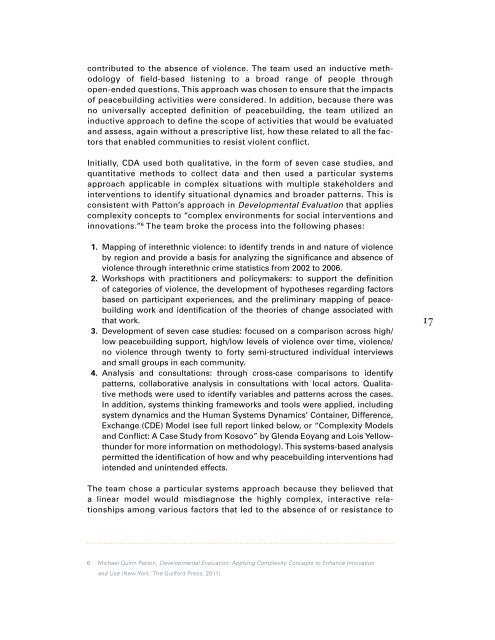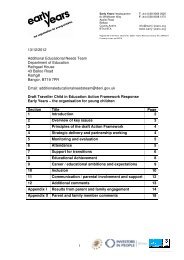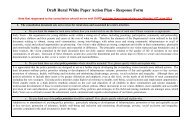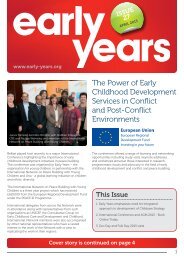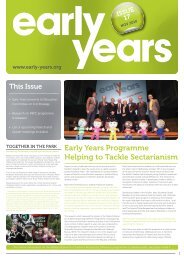Learning from Nine Examples of Peacebuilding Evaluation
Learning from Nine Examples of Peacebuilding Evaluation
Learning from Nine Examples of Peacebuilding Evaluation
Create successful ePaper yourself
Turn your PDF publications into a flip-book with our unique Google optimized e-Paper software.
contributed to the absence <strong>of</strong> violence. The team used an inductive methodology<br />
<strong>of</strong> field-based listening to a broad range <strong>of</strong> people through<br />
open-ended questions. This approach was chosen to ensure that the impacts<br />
<strong>of</strong> peacebuilding activities were considered. In addition, because there was<br />
no universally accepted definition <strong>of</strong> peacebuilding, the team utilized an<br />
inductive approach to define the scope <strong>of</strong> activities that would be evaluated<br />
and assess, again without a prescriptive list, how these related to all the factors<br />
that enabled communities to resist violent conflict.<br />
Initially, CDA used both qualitative, in the form <strong>of</strong> seven case studies, and<br />
quantitative methods to collect data and then used a particular systems<br />
approach applicable in complex situations with multiple stakeholders and<br />
interventions to identify situational dynamics and broader patterns. This is<br />
consistent with Patton’s approach in Developmental <strong>Evaluation</strong> that applies<br />
complexity concepts to “complex environments for social interventions and<br />
innovations.” 6 The team broke the process into the following phases:<br />
1. Mapping <strong>of</strong> interethnic violence: to identify trends in and nature <strong>of</strong> violence<br />
by region and provide a basis for analyzing the significance and absence <strong>of</strong><br />
violence through interethnic crime statistics <strong>from</strong> 2002 to 2006.<br />
2. Workshops with practitioners and policymakers: to support the definition<br />
<strong>of</strong> categories <strong>of</strong> violence, the development <strong>of</strong> hypotheses regarding factors<br />
based on participant experiences, and the preliminary mapping <strong>of</strong> peacebuilding<br />
work and identification <strong>of</strong> the theories <strong>of</strong> change associated with<br />
that work.<br />
3. Development <strong>of</strong> seven case studies: focused on a comparison across high/<br />
low peacebuilding support, high/low levels <strong>of</strong> violence over time, violence/<br />
no violence through twenty to forty semi-structured individual interviews<br />
and small groups in each community.<br />
4. Analysis and consultations: through cross-case comparisons to identify<br />
patterns, collaborative analysis in consultations with local actors. Qualitative<br />
methods were used to identify variables and patterns across the cases.<br />
In addition, systems thinking frameworks and tools were applied, including<br />
system dynamics and the Human Systems Dynamics’ Container, Difference,<br />
Exchange (CDE) Model (see full report linked below, or “Complexity Models<br />
and Conflict: A Case Study <strong>from</strong> Kosovo” by Glenda Eoyang and Lois Yellowthunder<br />
for more information on methodology). This systems-based analysis<br />
permitted the identification <strong>of</strong> how and why peacebuilding interventions had<br />
intended and unintended effects.<br />
17<br />
The team chose a particular systems approach because they believed that<br />
a linear model would misdiagnose the highly complex, interactive relationships<br />
among various factors that led to the absence <strong>of</strong> or resistance to<br />
6 Michael Quinn Patton, Developmental <strong>Evaluation</strong>: Applying Complexity Concepts to Enhance Innovation<br />
and Use (New York: The Guilford Press, 2011).


